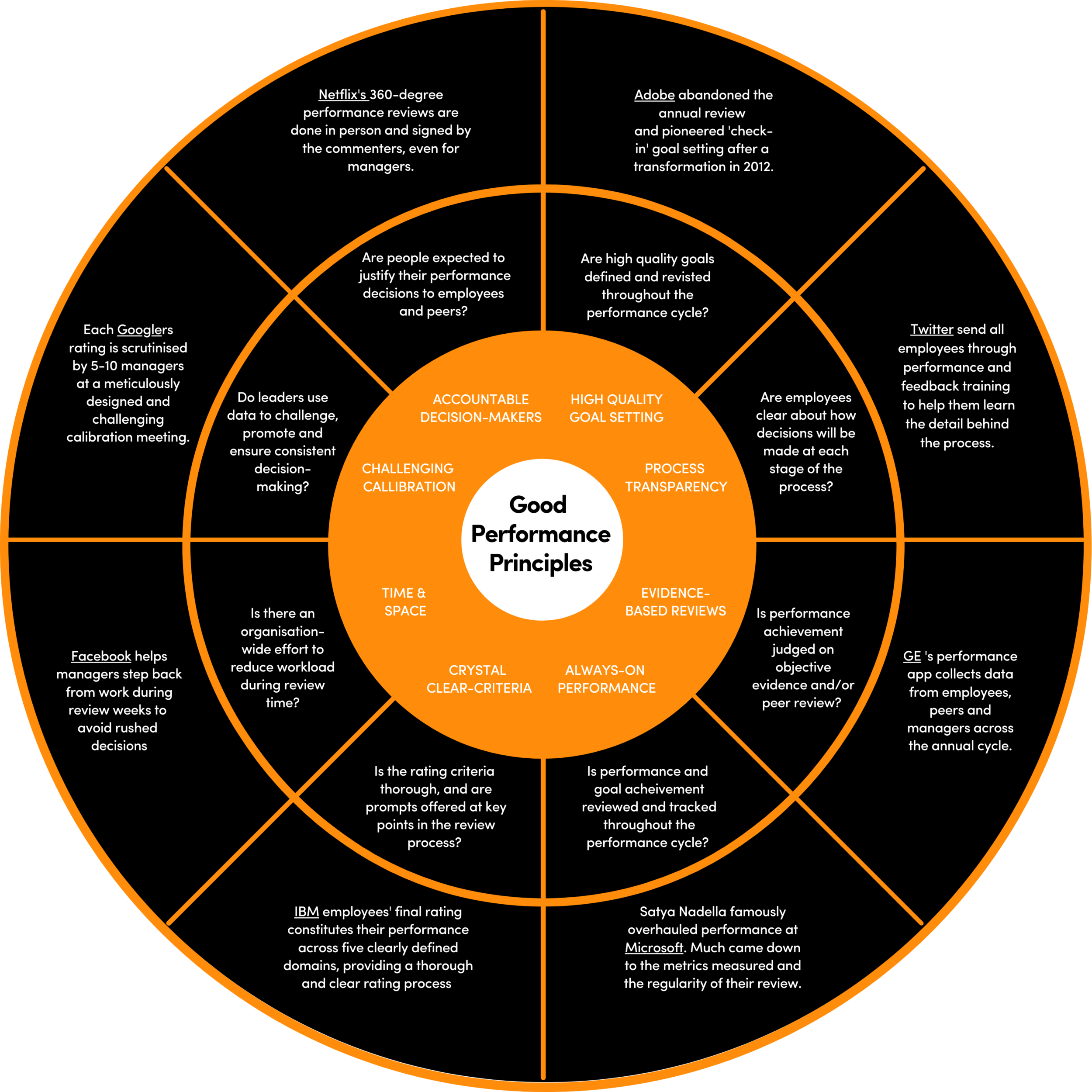Performance in a Virtual World
How will performance management change in a virtual world? No one can answer that question with full confidence, but we’re drawing on eight evidence-based principles as our platform for exploration.
None will sound ground-breaking in isolation, but they can be aligned with new technologies and working practices to redefine the future of performance. A thank you to all the academics and organisations behind this work. We share it as a way to continue that collective learning.
Accountable Decision-Makers
Accountability occurs when one's behaviour could fall under the scrutiny of another individual. Decision-makers experience accountability when they believe that their performance ratings have implications for their social image within their organisation (Harari & Rudolph, 2017).
The psychological mechanism behind accountability is pre-emptive self-criticism. When managers acknowledge that they will be held accountable for their ratings, they hold themselves to a higher standard throughout the decision-making process. Experiments in this domain have shown that accountable decision-makers search for and remember more information, engage in deeper analytical thinking, and make more consistent choices about their employees and peers (Aleksova et al, 2019). Accountability can be induced in numerous ways, including through the below principles of Calibration, Process Transparency and Evidence-Based Review.
High-Quality Goal Setting
Based on hundreds of studies, the major finding of goal setting is that individuals who are provided with specific, difficult but attainable goals perform better than those given easy, nonspecific, or no goals at all. At the same time, however, the individuals must have sufficient ability, accept the goals, and receive feedback related to performance acceptance (Lunenburg, 2011).
Goals have a two-way effect on performance ratings. Firstly, they provide an individualised and clear set of performance indicators to increase rater accuracy (London et al., 2004). Secondly, experiments have shown that goals set cooperatively by an employee and their supervisor lead to better subjective and objective performance and higher motivation (London et al., 2004; Vigoda-Gadot & Angert, 2007). This means that goals will not only provide an evaluative standard, but they will also motivate employees to reach them, especially if they can expect a positive outcome of doing so.
Process Transparency
Research has shown that the procedural and strategic transparency of organisations is positively associated with employee motivation, and thus company performance. The simple explanation for this phenomenon is that a clear understanding and alignment of individual goals with an organisation’s strategy is fundamental to driving the execution of that strategy (Berggren & Bernshteyn, 2007).
As a specific example, Swiercz et al. (2012) conducted a field experiment on a public service agency that introduced a performance appraisal process aimed at increasing and rewarding employee performance. They found that the perceived fairness of the system, originating from transparency, was linked to higher job performance, job satisfaction and organisational commitment. In a similar study, Salleh et al. (2013) concluded that this outcome can only be achieved through transparent processes, where employees exactly know what drives their performance reviews and how to control it.
Evidence-Based Review
An important factor in decreasing bias in performance ratings is providing and using all available high-quality information on employees. However, just putting this in front of raters is not enough. Psychological theories posit that prompts to recall and analyse all information are required to harness the full potential of data collected about employees (Larsen, 2019).
In fact, Koch et al.’s (2014) meta-analysis revealed that decision-makers who were motivated to make careful decisions tended to exhibit less gender bias in their ratings. Bauer and Baltes (2002; 2007) are pioneers in experimental research in the topic and demonstrate how this can be achieved through simple design changes (i.e. asking managers to recall five negative and five positive facts about individuals). This intervention eliminated gender and racial bias that appeared in the experimental groups who didn’t get a prompt to recall information.
Crystal Clear Ratings
Clear rating criteria have been widely connected to mutual trust between raters and ratees, as well as to increased rating accuracy. Establishing and training raters and ratees on the standards of performance appraisals ensures that ratings are consistent and fair across the entire organisation. Embedding clear criteria in the system helps to minimise cognitive biases as managers use the same standards and techniques throughout the process (Roch et al., 2012).
One helpful mechanism of training is to prompt recall. For example, Roch and O’Sullivan (2003) showed that trained raters recalled more rating-relevant behaviours after a 2-week delay than untrained raters. A few years later, a meta-analysis by Roch et al. (2012) confirmed the usefulness of criteria, showing that training specifically aimed at establishing a “frame of reference” increased rater accuracy across multiple studies.
Challenging Calibration
Diverse thinking styles can benefit the appraisal process by increasing accuracy and decreasing the likelihood of biased decisions (Picardi, 2015). In HR circles, using group consensus to refine ratings is defined as calibration. Multiple experiments have examined the extent to which group discussion and consensus affect the rating accuracy of appraisals. Roch (2006) and Picardi (2015) both found that raters who took part in calibration meetings showed higher rating accuracy than those in the control condition.
While overall, calibration meetings have been found to be useful in increasing rating accuracy, a study by Palmer and Loveland (2008) showed that rating accuracy decreased in calibration meetings when all group members held similar impressions of the ratee prior to the discussion. To solve this, Tetlock and Mitchell (2009) recommend inviting a diverse committee of raters to calibration meetings.
Time & Space
Ariely and Zakay (2001) write, “It takes time to make decisions, and sometimes the decision dynamically changes with the passage of time.” Rating performance is a complex process, and many have argued that error in such ratings often occurs as a result of evaluators’ lack of cognitive-processing capacity or failure to commit sufficient cognitive resources to the task (Vanhove et al., 2016).
Allowing sufficient time and space for performance ratings is essential to avoid the use of heuristics and biases that can result in distorted performance ratings. Studies on decision making across a wide range of contexts have shown that decision-makers often revert to simple strategies, old habits, and to the most easily accessible information when time pressure is high (Ordóñez et al., 2015).
For example, multiple experiments have shown that the introduction of a secondary task (an auditory monitoring task) during performance appraisal led to stronger susceptibility to gender biases (Vanhove et al., 2016). Increasing the number of candidates and rating dimensions can also place an extra load on raters and decrease rating accuracy (Melchers et al. 2010). Reducing the workload of rater managers at intensive points in the cycle is essential for another layer of insurance against biased performance decisions.
Always-on Performance Management
In the last decade, companies including Accenture, GE and Adobe have introduced an always-on culture to supplement their annual reviews. The detail varies, but the intention is to establish appraisal and feedback as routine elements of management practice. Continuous performance management has been welcomed by the scientific community since it appears to offer a more representative and fairer basis for an appraisal (Williams & Beck, 2018). Evans & Tourish (2016) emphasise the decreased need for formality devoted to monitoring, grading, ranking and rewarding. This means that even if employees receive a year-end rating, throughout the year, their feedback will be more likely to be geared towards their development rather than the financial outcomes of their performance.
Singh (2018) surveyed employees of a multinational tech company using this system and found that they perceived the continuous feedback system in place to be fair as their experience of participation was increased. Moreover, Bryant et al. (2011) describe that a similar system in Google’s Project Oxygen resulted in better-performing teams who stayed longer and had positive attitudes towards their work. Finally, always-on performance is not only important for employee happiness but also for supporting the fight against bias. Reflection and data collection throughout the year will be a reliable source of information when it comes to final ratings during the annual reviews.
These principles are the foundation of good performance management, and we look forward to experimenting with them in the months ahead. Get in touch if you would like to learn more.
Academic References
Aleksova et al. (2019): Lessons from five decades of experimental and behavioral research on accountability: A systematic literature review
Ariely & Zakay (2001): A timely account of the role of duration in decision making
Bauer and Baltes (2002): Reducing the effects of gender stereotypes on performance evaluations
Bauer and Baltes (2007): Does a structured free recall intervention reduce the effect of stereotypes on performance ratings and by what cognitive mechanism?
Berggren & Bernshteyn (2007): Organizational transparency drives company performance
Evans & Tourish (2016): Agency theory and performance appraisal: How bad theory damages learning and contributes to bad management practice
Harari & Rudolph (2017): The effect of rater accountability on performance ratings: A meta-analytic review
Koch et al. (2014): A meta-analysis of gender stereotypes and bias in experimental simulations of employment decision making
Larsen (2019): Using the elaboration likelihood model to explain performance appraisal inaccuracies
London et al. (2004): Performance management and assessment: methods for improved rater accuracy and employee goal setting
Lunenburg (2011): Goal-setting theory of motivation
Melchers et al. (2010): Do assessors have too much on their plates? The effects of simultaneously rating multiple assessment center candidates on rating quality
Ordóñez et al. (2015): Time-pressure perception and decision-making
Palmer & Loveland (2008): The Influence of Group Discussion on Performance Judgments: Rating Accuracy, Contrast Effects, and Halo
Picardi (2015): The effect of multi-rater consensus on performance rating accuracy
Roch & O’Sullivan (2003): Frame–of–reference rater training issues: Recall, time and behaviour observation training
Roch et al. (2012): Rater training revisited: An updated meta-analytic review of frame-of-reference training
Salleh et al. (2013): Fairness of performance appraisal and organizational commitment
Singh (2018): Continuous performance-based feedback and justice perceptions: Evidence for mediation by experienced participation
Swiercz et al. (2012): Predicting employee attitudes and performance from perceptions of performance appraisal fairness.
Tetlock & Mitchell (2009): Implicit Bias and Accountability Systems: What Must Organizations Do to Prevent Discrimination?
Vanhove et al. (2016): Rater agreement, accuracy, and experienced cognitive load: Comparison of distributional and traditional assessment approaches to rating performance Vigoda-Gadot & Angert (2007): Goal setting theory, job feedback, and OCB: lessons from a longitudinal study
Williams and Beck (2018): From annual ritual to daily routine: continuous performance management and its consequences for employment security
Case Study References
Doerr (2018): Why Adobe killed performance reviews
Feloni (2016): Facebook’s HR chief explains how the company does performance reviews
Homem de Mello (2019): Google’s performance management practices
Kruse (2012): 4 ways Twitter keeps its employees inspired engaged
McCord (2014): How Netflix reinvented HR
McKinsey Quarterly (2018): Microsoft’s next act
Nilsen (2015): Why GE had to kill its annual performance review after three decades
Zillman (2016): IBM is blowing up its annual performance reviews

